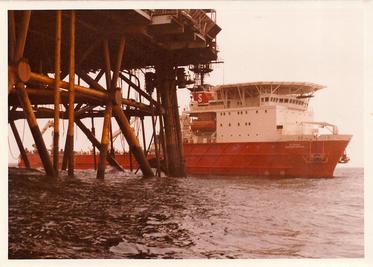Stena Seaspread diving accident facts for kids
| Date | 21 January 1981 |
|---|---|
| Location | Thistle oil field, East Shetland Basin, North Sea, Scotland |
| Cause | bell umbilical fouled on SALM |
| Participants | Phil Robinson, Jim Tucker |
| Outcome | successful through-water transfer to rescue bell |
The Stena Seaspread diving accident happened on January 21, 1981. During this event, a special diving bell, which held two divers, had its main lifeline cut. Luckily, both divers were safely rescued.
The Story Begins
On January 21, 1981, a supervisor named Mike Allen was in charge of a deep-sea dive. He was on the ship Stena Seaspread, which was near a large oil loading buoy called the Thistle SALM. Mike Allen had also helped with a rescue during another diving accident in 1979.
Around 10:00 AM, Mike O'Meara, the dive superintendent, checked in with Allen. Five hundred feet (about 150 meters) below the ship, diver Phil Robinson had just gone back into the diving bell. He was joining his partner, Jim Tucker. Robinson had been checking the SALM base for tiny cracks using a special method. He took a short break while his equipment recharged.
The Accident Happens
The Stena Seaspread was a new ship with a powerful system that kept it steady in the water. This system worked well, even with strong ocean currents. But no one knew that the tide had pulled too much of the divers' lifeline, called an umbilical, off its reel. This caused the umbilical to get tangled on the SALM buoy.
As the ship moved, a sharp part of the buoy cut a hole in the umbilical at 10:15 AM. This cut off the main gas supply to the divers. Mike Allen heard gas escaping, and the divers in the bell reported that their gas pressure was dropping. After confirming the leak, O'Meara asked Robinson to go outside the bell again. He used the bell's own gas supply to disconnect a rope and pack up their tools.
At 10:41 AM, while the divers' tools were being lifted, Allen lost all contact with the bell. The main umbilical had completely torn in half! It's thought that the basket holding the tools might have pulled on the tangled umbilical, causing it to snap. When the basket came out of the water, it had pieces of the umbilical stuck to it.
Allen quickly used a wireless system to talk to the divers. He found out they were okay. He then helped them check the bell to make sure all the important valves inside were closed.
Trying to Get Back Up
Unlike another diving bell that was lost on the seabed in a past accident, the Seaspread bell was still hanging from its lift wire. The main winch, which pulls the bell up, was still working. So, at 11:22 AM, Allen and O'Meara slowly started to pull the bell towards the surface.
But when the bell was 134 feet (about 40 meters) from the surface, Robinson and Tucker told Allen to stop. The bell was losing pressure again! They couldn't find out why it was leaking. Allen had to lower the bell back down to its working depth. At 11:47 AM, O'Meara declared an emergency and called for help from other diving support ships nearby. Later, they found out that the divers had forgotten to close a small valve inside the bell.
The Rescue Mission
About 20 miles (32 km) south, another large ship called the Uncle John was near the Brent Bravo oil platform. This was the same ship that had helped during the Wildrake accident. When the emergency call came in at 11:58 AM, a diving company called Comex Diving was using a ROV (a robot that works underwater).
The crew quickly pulled the ROV back to the ship. The captain of the Uncle John then started to empty the huge legs of the ship of water. This usually takes many hours, but the captain sped up the process. He used powerful fire cannons to pump water out, making the ship rise faster. As the Uncle John raced north to help, huge sprays of water trailed behind it.
Three hours later, the Uncle John arrived next to the Seaspread. Four hundred feet (122 meters) below the surface, Robinson and Tucker were staying warm in special sleeping bags. They were also using breathing masks that cleaned their air and recycled their body heat. After the Wildrake accident, divers learned that regular blankets weren't enough to protect against cold water. New survival suits were developed, and Robinson and Tucker were using these improved suits.
On the Seaspread, Allen and O'Meara talked about how to rescue the divers. They knew where Robinson and Tucker were, but they couldn't bring them to the surface. They decided to move the divers to a second rescue bell. This idea had been thought of during the Wildrake accident but wasn't used then.
On the Uncle John, diving supervisor George Head lowered the rescue bell. Inside were divers Joe Puttnam, Richard Taylor, and Ken Iversen. At 400 feet (122 meters) deep, they connected the two bells with a rope. They also sent a hot-water hose to the stranded divers to warm them up. Then, they helped Robinson, and then Tucker, move safely into the rescue bell. For their bravery in the rescue, Joe Puttnam and Richard Taylor received a special award called the Queen's Commendation for Brave Conduct.


